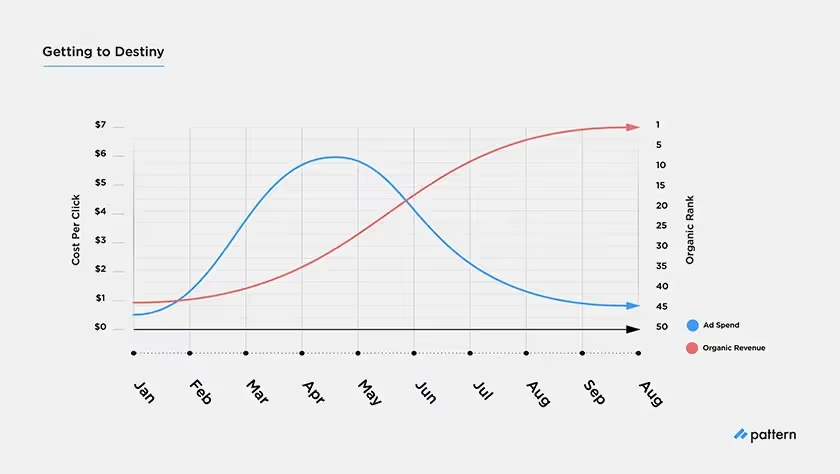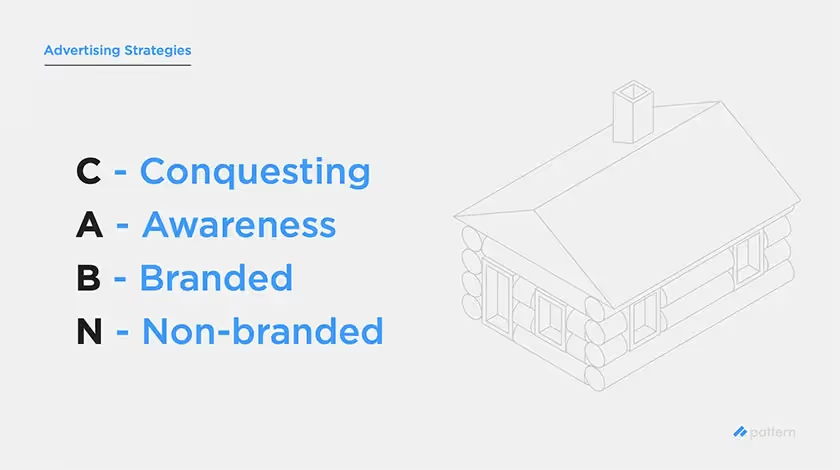3 Game-Changing Methodologies for Optimizing Digital Shelf, SEO, & Advertising
Want to optimize sales on Amazon and other marketplaces? Use a data-driven strategy with Pattern's Digital Shelf and Laddered Destiny technology.
2020 was a devastating year for many markets, but ecommerce isn’t one of them. The year catapulted ecommerce a decade into the future, and ecommerce sales were at an all-time high going into 2021. The unforseen acceleration of eccomerce shows it’s never been more important for brands to optimize their Amazon strategies.
On a Pattern webinar about digital shelf, SEO, and advertising, CEO and co-founder Dave Wright and Chief Revenue Officer John LeBaron discussed how brands can step up their ecommerce game in 2021 by fine-tuning their SEO and advertising strategies using data-backed tools and methodologies.
1. The executive dilemma: Ecommerce teams are set up to fail
Wright started the webinar by describing what he calls the executive dilemma—the gap between what small ecommerce teams can realistically do and what executives expect them to do. It’s unrealistic, Wright said, to expect a small in-house ecommerce team to successfully handle everything it takes for a brand to thrive online. Even enormous companies place the burdens of logistics and distribution squarely on the shoulders of a team of 3 or 4 people.
The same team is also expected to learn several different pieces of software to make sure everything is running smoothly online. In general, Wright said, companies use 19 different pieces of software to run Shopify alone. As if that weren’t enough, ecommerce teams also take responsibility for driving traffic to the product and ensuring conversion—which includes creating top-notch imagery, video, and content, and running tests to make sure these messages are resonating with consumers.
Executives then expect these small teams to branch out to foreign countries and languages and establish a strong presence on marketplaces like Amazon and Alibaba. “This quickly becomes a gigantic problem to solve—for three people, a near impossibility,” Wright said. “If it doesn’t come at an executive level, then somebody down in the trenches needs to help the executive team understand that what they’re asking them to do is a near impossibility.”
The misconception that even the best ecommerce team can handle every aspect of a businesses’ online presence is costing companies millions of dollars in lost sales and lost markets, Wright said. That’s why it’s critical to team up with an experienced ecommerce partner that can help you handle the nitty-gritty facets of ecommerce and successfully expand to global markets.
2. Digital Shelf: Understanding competition on ecommerce
Pattern is an ecommerce accelerator that exists to simplify ecommerce for brands while propelling their sales and growth. Partnering with us is like pushing a “big green easy button,” as Wright called it, since we take over the tedious parts and leave you with more time, resources, and revenue. Along with our expert teams, we have 4 products in our tech stack that help us do that: Destiny, Predict, Shelf, and Share.
In this webinar, Wright focused on Destiny, which helps brands identify their competitors and win keywords on Amazon by driving more traffic to product listings. Wright explained two key concepts that are central to Destiny, the first being a digital shelf of competitors. Just like competing products are placed together on a physical shelf in brick-and-mortar stores, the digital shelf helps brands understand their true Amazon competition based on which products appear next to theirs in searches.
“Brands often think their retail competitors are their competitive set, but when you get into the Amazon landscape, there are lots of competitors there who don’t show up anywhere else,” Wright said. “Oftentimes, they’re more true competitors. They’re people really stealing your market share, they’re people you’re really competing with.”
3. Laddered Destiny: Selecting strategic ad keywords to increase organic rank
The second concept is the idea of Laddered Destiny, a model that helps brands select keywords they can realistically win, spend advertising money until their products become organically ranked for said keywords, and then move on to other keywords or keyword phrases. On average, Pattern’s Predict software gives 1,500 to 2,000 keywords for any given product.
In the Laddered Destiny model, we rank these keywords according to destiny—given the product’s quality, price, and reviews compared to competitors on the digital shelf, which keyword searches can it realistically win? And once we’ve won those keyword searches, how can we keep climbing our way up the ladder? To explain Laddered Destiny, Wright used the example of a probiotic.
At first, a probiotic product may only have the destiny to win a niche keyword search, like “probiotic for women over 50.” Once that product starts spending ad money and organically dominating in that niche space, however, it may then have the destiny to win “probiotics for women” and eventually even just “probiotic.” The concept is to keep climbing the ladder and win more and more keywords to increase traffic and ultimately increase conversion and revenue.

“You’ll get great traction on this if you really spend the time doing a great job at the product level,” Wright said. “This model will work tremendously well because you do have destiny. So if you’re saying to yourself, ‘Gosh, I know I’ve got an amazing product,’ and you just need to get it out there, that’s what we’re really good.”
How Laddered Destiny changes the game for SEO and advertising
The information we glean from Laddered Destiny is extremely valuable in forming effective SEO and advertising strategies. Running an ASIN through the software tells brands exactly which keywords are both relevant to their digital shelf of competitors and realistic for them to win. This makes it easy to make data-backed decisions on which keywords to include in product titles and listings and where to pour advertising dollars. During the webinar, Wright ran a live Laddered Destiny demo, using a product from the sock brand Feetures as an example. First, the software determined Feetures’ digital shelf, listing the ASINs of its direct competitors.

With the digital shelf determined, Wright could then pull up the keyword and keyword phrases that the products of the digital shelf, including Feetures’ products, were winning on Amazon. Some of these keywords included “running socks women,” “women’s running socks,” and “women’s no show running socks.” Finally, with all this information, the software generated SEO and bigram recommendations specific to Feetures and its digital shelf.

Although Feetures brands its products as unisex, it’s clear they have destiny around keywords specific to women’s running socks and that the products on their digital shelf dominate in keyword searches relating to women’s socks. However, the demo revealed that the product title doesn’t even mention the word “woman.”
According to Wright, these kinds of mistakes are easy to make when you don’t have the data. “Just taking a pure data science approach to winnability at a keyword or keyword phrase level using the digital shelf is game-changing,” Wright said. “When you start running this and seeing the impact you can have on a given product, it’s enormous. And it’s really not that hard, but it’s difficult to put all these pieces together into an overall strategy, especially if you’ve got 3 people on the team.”
LeBaron added that while ad spend can initially increase while starting the Laddered Destiny model, it gradually gets less expensive as a product starts winning organic search terms. When a product listing starts organically appearing in the top 4 search results, the Laddered Destiny technology will turn off advertising for that word and only turn it back on if the product slips lower than the seventh spot. “We don’t spend on advertising to just generate additional supplementary revenue,” LeBaron said. “We spend on advertising to build organic rank. And in turn, we end up actually spending less on advertising.”

Apart from Destiny, we use a four-part advertising strategy called CABN (Conquesting, Awareness, Branded, Non-branded.) Each main topic plays together but has a separate playbook and strategy. A brand may be focusing on different models at the same time, like by simultaneously investing in both an awareness campaign and a conquesting campaign.

Pattern’s ad tech and advanced machine learning make CABN possible. For example, once a brand has decided how much money they can spend on conquesting a particular competitor, the machine will then go after keywords related to that conquest. The conquesting learns over time, so if it successfully pursues a keyword phrase, the feedback loop leads it to double down on that keyword and start increasing the bid naturally.
“If somebody starts jacking up the price on, let’s say, probiotic, the machine will start stepping away from that because it will find better value propositions and other keywords or keyword phrases,” Wright said. “Without using some tech around this, you’ll just get destroyed.” Once the machine starts learning and seeing where a brand can get real results, we then give our brands data-backed recommendations for keywords and advertising strategy.
Interested in learning more about how you can partner with Pattern to step up your Amazon strategy in 2021? Contact us using the form below.


.jpg)






.jpg)
%20(1).jpg)